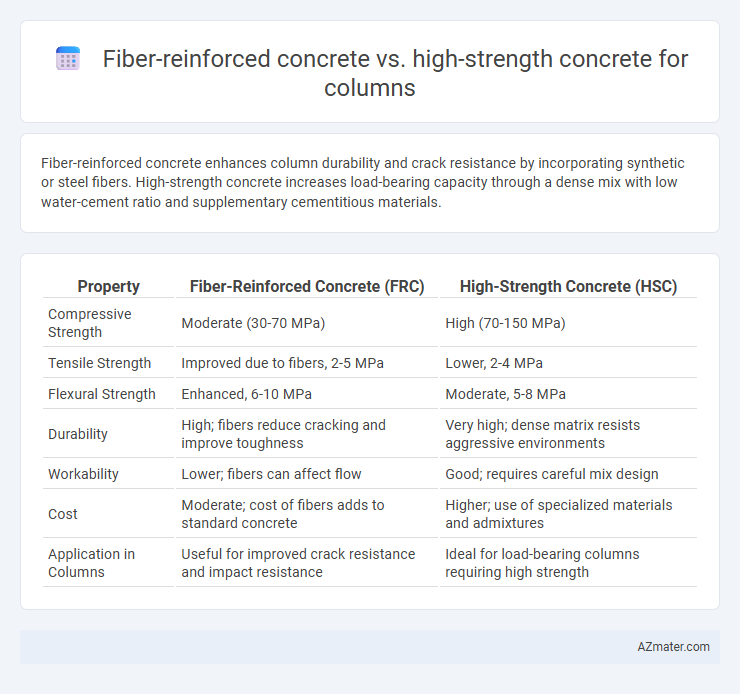Fiber-reinforced concrete enhances column durability and crack resistance by incorporating synthetic or steel fibers. High-strength concrete increases load-bearing capacity through a dense mix with low water-cement ratio and supplementary cementitious materials.
Table of Comparison
| Property | Fiber-Reinforced Concrete (FRC) | High-Strength Concrete (HSC) |
|---|---|---|
| Compressive Strength | Moderate (30-70 MPa) | High (70-150 MPa) |
| Tensile Strength | Improved due to fibers, 2-5 MPa | Lower, 2-4 MPa |
| Flexural Strength | Enhanced, 6-10 MPa | Moderate, 5-8 MPa |
| Durability | High; fibers reduce cracking and improve toughness | Very high; dense matrix resists aggressive environments |
| Workability | Lower; fibers can affect flow | Good; requires careful mix design |
| Cost | Moderate; cost of fibers adds to standard concrete | Higher; use of specialized materials and admixtures |
| Application in Columns | Useful for improved crack resistance and impact resistance | Ideal for load-bearing columns requiring high strength |
Introduction to Fiber-Reinforced Concrete and High-Strength Concrete
Fiber-reinforced concrete incorporates discrete fibers such as steel, glass, or synthetic materials to enhance tensile strength, ductility, and crack resistance in structural columns. High-strength concrete achieves compressive strengths typically above 6,000 psi through optimized mix designs and admixtures, improving load-bearing capacity and durability. Both materials offer distinct advantages for column construction, with fiber-reinforced concrete excelling in toughness and crack control, while high-strength concrete provides superior compressive performance.
Key Material Properties of Fiber-Reinforced Concrete
Fiber-reinforced concrete (FRC) exhibits enhanced tensile strength, toughness, and crack resistance compared to high-strength concrete, making it ideal for columns subjected to dynamic loads and impact. The incorporation of fibers, such as steel or synthetic fibers, improves ductility and energy absorption, reducing brittle failure often seen in high-strength concrete. Fiber volume fraction, fiber type, and matrix composition critically influence the mechanical behavior and durability of fiber-reinforced concrete in structural columns.
Essential Characteristics of High-Strength Concrete
High-strength concrete (HSC) exhibits superior compressive strength typically above 6000 psi (41 MPa), offering enhanced durability and reduced permeability compared to fiber-reinforced concrete, making it ideal for columns subjected to high axial loads. Its essential characteristics include a low water-cement ratio, optimized mix design with silica fume or superplasticizers, and a dense microstructure that improves resistance to cracking and chemical attacks. Fiber-reinforced concrete primarily enhances tensile strength and toughness, but HSC's key advantage lies in its ability to sustain significant load-bearing capacity with improved long-term performance in structural columns.
Structural Performance in Columns: A Comparative Overview
Fiber-reinforced concrete (FRC) enhances column structural performance by improving tensile strength, crack resistance, and energy absorption, making it ideal for seismic and impact loads. High-strength concrete (HSC) offers superior compressive strength, enabling slender column sections and higher load-bearing capacity in high-rise structures. Combining FRC with HSC can optimize durability, ductility, and load resistance in columns under complex stress conditions.
Load-Bearing Capacity: Fiber-Reinforced vs High-Strength Concrete
Fiber-reinforced concrete enhances load-bearing capacity by improving tensile strength and crack resistance, resulting in better energy absorption under stress. High-strength concrete offers superior compressive strength, making it ideal for columns subjected to heavy axial loads. Combining fibers with high-strength concrete can optimize load-bearing performance by balancing strength and ductility in structural columns.
Crack Resistance and Durability in Column Applications
Fiber-reinforced concrete enhances crack resistance in column applications by effectively controlling microcracks through fiber distribution, resulting in improved durability under cyclic loading and impact conditions. High-strength concrete offers superior compressive strength but tends to exhibit brittle failure and limited crack control, potentially reducing long-term durability in columns exposed to dynamic stresses. Optimal column performance in terms of crack resistance and durability is achieved by integrating fiber reinforcement into high-strength concrete mixtures, combining strength with enhanced toughness and crack mitigation.
Construction Techniques and Workability Differences
Fiber-reinforced concrete (FRC) improves workability in columns by enhancing the mix's cohesiveness and reducing segregation, making placement easier in complex forms and reducing the need for additional vibration. High-strength concrete (HSC) requires precise mix proportions and careful curing to achieve its strength, often resulting in lower workability and a higher risk of shrinkage or cracking without meticulous handling. Construction techniques for FRC focus on uniform fiber dispersion and appropriate mixing equipment to maintain flowability, while HSC demands controlled batching and curing processes to ensure structural integrity and minimize defects in columns.
Cost Analysis: Fiber-Reinforced vs High-Strength Concrete Columns
Fiber-reinforced concrete columns generally incur lower material costs compared to high-strength concrete due to the reduced requirement for specialized cement and admixtures. The inclusion of fibers enhances structural durability and crack resistance, potentially lowering long-term maintenance expenses. High-strength concrete demands higher-quality aggregates and cementitious materials, driving initial costs upward despite its superior load-bearing capacity.
Best Use Cases for Each Concrete Type in Columns
Fiber-reinforced concrete excels in columns subjected to dynamic loads, impact, or seismic activity due to its enhanced toughness, crack resistance, and energy absorption properties. High-strength concrete is optimal for columns requiring high compressive strength and slender proportions in high-rise structures, where load-bearing capacity and durability dominate design criteria. Selecting the appropriate concrete type depends on structural demands, with fiber-reinforced concrete suited for improved ductility and damage control, while high-strength concrete supports maximum load capacity and stiffness.
Conclusion: Selecting the Optimal Concrete for Column Design
Fiber-reinforced concrete enhances ductility and crack resistance, making it ideal for columns subjected to dynamic loads and impact forces. High-strength concrete offers superior compressive strength and durability, suitable for columns requiring high load-bearing capacity in tall structures. Selecting the optimal concrete depends on project-specific structural demands, balancing strength requirements with toughness and long-term performance.

Infographic: Fiber-reinforced concrete vs High-strength concrete for Column
 azmater.com
azmater.com